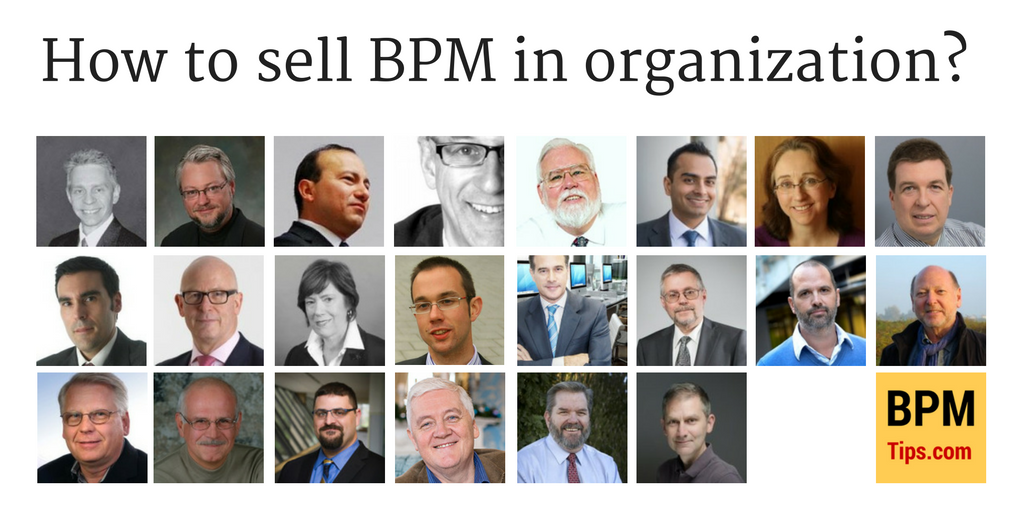Did you ever wonder how to convince executives to treat BPM as something more than just one more management method? Or how to make employees care?
Many of my readers asked those questions, so I decided to bring you answers 🙂
I asked some of the best BPM experts a question “How to sell Business Process Management in an organization?” and got really amazing answers you can find below.
PLUS – 10+ experts extended their answers and recorded video interviews as a part of BPM Value Summit.
Do you want to watch videos from BPM Value Summit?
Yes! I want to learn from BPM experts

The post is pretty long, so I have added navigation to make your life easier:
Jim Boots
Lloyd Dugan
Prof. Marlon Dumas
Ian Gotts
Paul Harmon
Sandeep Johal
Sandy Kemsley
Mathias Kirchmer
Alberto Manuel
Derek Miers
Connie Moore
Adrian Reed
Pedro Robledo
Alexander Samarin
Ivan Seselj
Alec Sharp
Jim Sinur
Andrew Spanyi
John Tesmer
Steve Towers
Roger Tregear
Neil Ward-Dutton
Now, let’s dive into the answers.
Jim Boots
 Jim Boots worked at Chevron Corporation for 30 years in a wide array of functions including sales, total quality management, business development, supply chain management, business management, e-commerce management, health safety & environment management, enterprise architecture, and Business Process Management (BPM) program development.
Jim Boots worked at Chevron Corporation for 30 years in a wide array of functions including sales, total quality management, business development, supply chain management, business management, e-commerce management, health safety & environment management, enterprise architecture, and Business Process Management (BPM) program development.
He was the primary force behind building Chevron’s BPM foundation from 2005-2010.
He also is a Principal IT-CMF Professional at the Innovation Value Institute with responsibilities that include a role as Lead Architect of the BPM Critical Capability.
He is author of the book, “BPM Boots on the Ground: How to Implement Strategic Business Process Management: Lessons Learned from one of the World’s Largest Organizations” and co-author of a recent book “Questioning BPM?”. Jim runs his own BPM consultancy known as Global Process Innovation.
WWW: LI profile
WWW: Company
In terms of getting executives to understand BPM and commit to implementing a robust version of it, it is hard, if not impossible, to persuade an executive who doesn’t have a naturally process-oriented mindset. Some executives don’t have that. Some simply rely on communicating goals and then assume that their knowledgeable employees will be able to figure out the processes needed to achieve the desired outcomes. If an executive is not “process-receptive,” then probably no amount of persuasion will help. A good first test of an executive’s mindset is to ask him or her whether it is worthwhile for executives and employees to spend time talking about how work should be done rather than always exclusively focusing on actually doing work. Some people have no patience for talking about work; they only feel useful if they are doing work rather than talking about it. People who have this strong “action orientation” probably will not perceive process work as useful.
If an executive is receptive to the idea that work processes (and the results that come from them) can be improved by rigorously talking about and documenting them, then there is a chance of persuading the executive that implementing BPM will add value. There are many things one can say about the benefits of BPM, but most people are more receptive when they see an example that is meaningful to them. So, after a brief introduction of what BPM is and its benefits, it often is helpful to focus on the business of the organization – which executives care deeply about – by asking them to help draw the top level of the organization’s process architecture. Someone who is skilled at process mapping can develop a draft process diagram within 30 minutes (preferably using commercially available software, but a piece of paper also is acceptable). As the executive begins seeing his/her organization’s work processes represented at the top level, the persuader can explain how the top level diagram can serve as the primary framework for a BPM project wherein priority areas are identified by the executives, then employees create lower level diagrams that are decomposed from – and are therefore aligned with – the top level. Such an approach makes the discussion more concrete. Otherwise, executives often feel that BPM conversations are too theoretical and/or that they get mired in detail.
Once an executive buys into the idea of a BPM initiative, getting employee buy-in in most organizations can be relatively straightforward. My suggestion is to frame the initiative as one that empowers or enables employees to perform their responsibilities with excellence. Most people like that idea. As employees do process mapping or undertake process improvements under the guidance of a skilled facilitator, they often take pride in the accurate depiction of best practice processes that have been distilled from their collective knowledge. (An exception can be in organizations that are focused on cost reduction as employees may feel that more efficient and effective processes will lead to workforce reductions. Naturally, they may be resistant to making processes work better if they might lose their jobs as a result.)
In summary, the hardest – and absolutely essential – thing is to have an executive sponsor who is committed to BPM over the long term. Different executives respond to various arguments in favor of BPM, but demonstrating process thinking by drawing the top level of a process architecture can make it seem real for some. Once the right executives are behind the BPM initiative, focusing on employee empowerment usually builds enthusiasm across the workforce.
Lloyd Dugan
 Lloyd Dugan is a widely recognized thought leader in the development and use of leading modeling languages, methodologies, and tools, covering from the level of EA and BA down through BPM, Case Management, and SOA. He specializes in the use of standard languages for describing business processes, systems, and services, particularly BPMN, CMMN, and DMN from the OMG. He has developed and delivered BPMN 2.0 training to the U.S. Department of Defense and large consultancies. He has nearly 30 years of experience with public and private sector clients, and has an MBA from the Fuqua School of Business at Duke University. He is an OMG-Certified Expert in BPM (OCEB) – Fundamental, a member of the Workflow Management Coalition and its BPSim Working Group, a member of the OMG’s BPMN Model Interchange Working Group (MIWG), and a Contributing Member (author), Meta Modeling and BPM-BA Alignment Collaboration Teams Member, and Advisory Board Member of the Business Architecture Guild. He is a frequent speaker at national and international conferences on BPM, BPMN, Case Management, SOA, and BA. He is a published author or co-author on BPM, BPMN, and BA. He serves as the Chief Architect for Business Process Management, Inc. (see www.bpm.com), for whom he delivers BPM-related training and client advisory services on BPM-related matters and technologies.
Lloyd Dugan is a widely recognized thought leader in the development and use of leading modeling languages, methodologies, and tools, covering from the level of EA and BA down through BPM, Case Management, and SOA. He specializes in the use of standard languages for describing business processes, systems, and services, particularly BPMN, CMMN, and DMN from the OMG. He has developed and delivered BPMN 2.0 training to the U.S. Department of Defense and large consultancies. He has nearly 30 years of experience with public and private sector clients, and has an MBA from the Fuqua School of Business at Duke University. He is an OMG-Certified Expert in BPM (OCEB) – Fundamental, a member of the Workflow Management Coalition and its BPSim Working Group, a member of the OMG’s BPMN Model Interchange Working Group (MIWG), and a Contributing Member (author), Meta Modeling and BPM-BA Alignment Collaboration Teams Member, and Advisory Board Member of the Business Architecture Guild. He is a frequent speaker at national and international conferences on BPM, BPMN, Case Management, SOA, and BA. He is a published author or co-author on BPM, BPMN, and BA. He serves as the Chief Architect for Business Process Management, Inc. (see www.bpm.com), for whom he delivers BPM-related training and client advisory services on BPM-related matters and technologies.
WWW: BPM.com
WWW: LI profile
It is undoubtedly a cliché to say this, but a business case is needed – even for BPM efforts. With its focus on processes (principally automation of same), the business case vectors to leverage have traditionally been efficiency improvements over quality improvements. In the case of the former, this was often (preferably and more palatably) presented as “cost avoidance” – the consequence being the capability to scale without increasing the cost base – as opposed to “cost reduction” (though that was often the hidden agenda). Clearly, this was predicated on showing some serious ROI on the generally expensive investment in the BPMS platform from which to automate those business processes – a heavy burden given the price of the platform and a long history of over budget and past due deliveries.
As a specialized sub-discipline (or at least on overlapping one) of BPM, case management shifts the emphasis to quality due to its focus on outcomes. This actually makes KPIs even more important than in traditional BPM efforts. The business case then must address more of the business importance of improved outcomes, which may or may not be easily monetized for discrete comparisons ala ROI. Thus, the burden in these situations is still high but for a different reason: better outcomes must be objectified in a way that sells the work.
Aside from the fact that good business case construction is a poorly understood and only loosely practiced discipline (despite claims to the contrary), there is a much larger problem associated with selling the value of BPM efforts: whatever one calls the NPV for the work, it is a result often devoid of what the business (in the form of the senior managers) really needs to see as the reason(s) for doing the work. Consider that ordinal or even cardinal measures of value are inextricably tied to the dimensions of the BPM effort itself, which may or may not align well with how the business actually sees itself. For that perspective, you need some kind of Business Architecture in which to see how a BPM effort improves one or more value streams (with receiving as well as participating stakeholders), or one or more capabilities that impact the success of the effective business model or the ability to execute on strategic goals and objectives. Too often BPM efforts proceed without establishing and/or aligning with this context, leaving the “value” being sold to be a more subjective exercise.
In the end, selling BPM to the organization must learn, embrace, and reflect back the vocabulary with which the business understands itself. Otherwise, it is a software license sale that is seen as a cost center moment, and can be subject to overly reductive evaluations.
Prof. Marlon Dumas
 Marlon Dumas is Professor of Software Engineering at University of Tartu, Estonia where he leads a team of 15 researchers focused on Business Process Management (BPM). Previously, he was faculty member at Queensland University of Technology and visiting researcher at SAP Research, Australia, where he led several BPM-related applied research projects. Prof. Dumas has provided consultancy and training to a dozen organizations in Australia and the Baltics. He is co-inventor of six granted US/EU patents in the field of BPM and co-author of the textbook “Fundamentals of Business Process Management”, now used in more than 100 universities worldwide.
Marlon Dumas is Professor of Software Engineering at University of Tartu, Estonia where he leads a team of 15 researchers focused on Business Process Management (BPM). Previously, he was faculty member at Queensland University of Technology and visiting researcher at SAP Research, Australia, where he led several BPM-related applied research projects. Prof. Dumas has provided consultancy and training to a dozen organizations in Australia and the Baltics. He is co-inventor of six granted US/EU patents in the field of BPM and co-author of the textbook “Fundamentals of Business Process Management”, now used in more than 100 universities worldwide.
WWW: LI profile
WWW: Website
When making a case for BPM, it is crucial to align it with the strategic directions of the company. The Value-Driven BPM (VBPM) framework is a useful tool in this context. At the heart of this framework is the “transparency” value, which refers to the ability for BPM to help different stakeholders in the business to better understand and monitor their processes. Once transparency is in place, BPM can deliver value along three axes, each one corresponding to a pair of values. The first axis is the efficiency-quality pair, which captures the tradeoff between fulfilling the needs of the customer effectively (quality) and streamlining the processes to fulfill these needs efficiently (e.g. at minimum cost). The second axis is the agility-compliance pair and captures the dichotomy between being able to rapidly adapt to a changing business environment vs. safeguarding the processes to ensure that they comply with relevant regulations and standards. The final axis (integration-networking pair) captures the dual imperative for organizations to maintain their internal resources and systems well integrated, and to expose these systems optimally to customers and to external parties in order to exploit collaborative business opportunities.
Traditionally, when making a case for BPM, we tend to focus on transparency, quality, efficiency and sometimes compliance. However, the emergence of digital disruptors makes it necessary to re-focus BPM towards adaptability and networking. BPM can significantly enhance the ability for the organization to change continuously and effectively. It also allows organizations to optimize their customers’ experience, to
collaborate with external parties and to become more anticipatory. Successful global and regional retailers are doing just that, for example Walmart, CVS, Amazon and Kogan. Having optimized and computerized their processes along the quality-efficiency axis for years, they have managed to turn them into an asset for enabling adaptability and networking.
Ian Gotts
 Ian is a founder of Q9 Elements, tech advisor, investor, speaker and author.
Ian is a founder of Q9 Elements, tech advisor, investor, speaker and author.
Q9 Elements is a startup software company. It is looking to disrupt the BPM marketplace and enable clients to deliver huge levels of ROI.
WWW: iangotts.com
WWW: LI profile
External stakeholders don’t really care about operational processes. They absolutely don’t care about process analysis. And if you talk about BPM they’ll look straight through you. Never talk to an exec about BPM.
Exec’s care about results. Outcomes. Impact.
Listen to the words they use in this video https://www.youtube.com/watch?v=MsEALCm3zUU
Paul Harmon
 Paul Harmon is a Co-Founder, Executive Editor, and Senior Market Analyst at Business Process Trends – www.bptrends.com – an internationally popular website that provides a variety of free articles, columns and book reviews each month on trends, directions and best practices in business process management.
Paul Harmon is a Co-Founder, Executive Editor, and Senior Market Analyst at Business Process Trends – www.bptrends.com – an internationally popular website that provides a variety of free articles, columns and book reviews each month on trends, directions and best practices in business process management.
Paul is also a Co-Founder, Chief Methodologist, and a Principal Consultant of BPTrends Associates (BPTA), a professional services company providing executive education, training, and consulting services for organizations that are interested in understanding and implementing business process management.
Paul involvement in business process change dates back to the late 60’s when he worked with Geary Rummler, at Praxis Corp., and was responsible for managing the overall development and delivery of the performance improvement projects undertaken by that company. During the 70s and 80s he ran his own company, Harmon Associates, and undertook major process improvement programs at Bank of America, Security Pacific, Wells Fargo, Prudential, and Citibank, to name a few.
During the same period he was a Senior Consultant at Cutter Consortium and edited their Expert System Strategies, CASE, and Business Process Reengineering Strategies newsletters.
Paul is the author of Business Process Change: A Guide for Business Managers and BPM and Six Sigma Professionals (Morgan Kaufman, which issued the heavily revised second edition in 2007). He has authored or co-authored over twelve other books, including the very popular Expert Systems: AI for Business (1983) and is the co-author and editor of the BPTrends Product Reports, a widely read series of reports on BPM software products that are available on the www.bptrends.com site. Paul Harmon also writes two short articles each month on current BPM topics, which are mailed to the members of the BPTrends website.
Paul Harmon is an acknowledged BPM thought leader who is concerned with applying new technologies and methodologies to real-world business problems. He is a speaker and has developed and delivered executive seminars, workshops, briefings and keynote addresses on all aspects of BPM to conferences and at major organizations throughout the world.
WWW: BPTrends
I’ve rarely seem BPM or process sold by itself. Generally an organization has another problem – it wants to improve sales, or avoid some defective practice, or standardize ERP. Someone from the process area steps forward and says: “I know how to solve this problem!” and proceeds to describe a process-based solution.
Process is all about seeing problems as wholes; its about seeing how diverse groups or activities somehow work together to generate the desired results. Obviously I’m using the term “process” broadly. I don’t mean to suggest that one simply draws flow diagrams, or looks for “waste” that can be eliminated — although those approaches can be valuable in the right circumstances. Instead, I am advocating an attitude or a comprehensive perspective, if you would, that begins with an overview of all of the activities that must be undertaken to deliver value to customers and return on investment to management, and so forth. Once one has a holistic perspective, then one is prepared to begin to see relationships that may not be seen by someone looking at a problem from some more limited perspective. In essence, selling process involves selling a perspective — a way of thinking about business problems.
But, as I’ve already suggested, selling a perspective is hard. It’s better to demonstrate the value of the perspective by showing, in concrete situations, how it can solve problems.
Sandeep Johal
 Sandeep has contributed professionally and academically to Business Process Management for 10 years. He specializes in business process modeling and governance. He currently leads a team of Business Process professionals in the United States.
Sandeep has contributed professionally and academically to Business Process Management for 10 years. He specializes in business process modeling and governance. He currently leads a team of Business Process professionals in the United States.
His business process management practice helped accumulate years of questions and lessons which are shared through social media, videos, classes, seminars and, of course, consulting. Sandeep has presented at international conferences across Australia, United States, England, and the Middle East.
He recently developed Process Modeling Excellence, a 40 day program to establish or uplift the process modeling capability of any organization.
Sandeep is a BPTrends accredited Business Process Management Professional and has a Master of Business Process Management.
WWW: LI profile
WWW: Company blog
Here are my thoughts on selling BPM:
Problems and context:
- Selling BPM is difficult
- But without delivering value BPM cannot be sold
- ‘Traditional selling’ techniques have produced limited success
- Needs different thinking to solve issue of selling BPM
General principles, approach & solution:
- Use contemporary ‘inbound’ selling techniques https://en.wikipedia.org/wiki/Inbound_marketing
- Offer only value: Less ‘selling’, more ‘benefits’
- ‘Follow up’ and have customers come back to you
- Get people excited about BPM
On-the-ground tactics for selling BPM:
- Involve marketing and communication professionals. This job of selling should not be confined to just BPM professionals.
- Perform a buyer persona analysis https://en.wikipedia.org/wiki/Persona_(user_experience)
- Communicate, communicate, communicate (e.g. create digital watercooler)
Sandy Kemsley
 Sandy is a “technology catalyst” with a 20-year history of software design and systems architecture in several technology areas, combined with a deep understanding of business environments and how technology can impact them.
Sandy is a “technology catalyst” with a 20-year history of software design and systems architecture in several technology areas, combined with a deep understanding of business environments and how technology can impact them.
She has also founded and run three companies – a systems integration services company, a software product company, and current consulting company – with responsibility for corporate and financial governance, strategic direction, team hiring and management, and day-to-day technical contributions.
Sandy blogs about BPM, enterprise architecture and other intersections of business and technology at www.column2.com
WWW: LI profile
WWW: Column 2
BPM as a management practice provides the benefit of being able to see the end-to-end processes within an organization, to really understand what goes into making the company’s product/service and serving the customer. It allows everyone to understand how their role contributes to that customer journey, which can be a big incentive for workers regardless of their level in the organization.
When you add BPM technologies to that, it brings the ability to automate the tedious parts of the process, such as data entry, which allows workers to focus on more interesting tasks that require their experience and decision-making skills.
Dr. Mathias Kirchmer
 Dr. Kirchmer is a visionary leader, thought leader and innovator in the field of Business Process Management (BPM), combining his broad practical business experience with his extensive academic research. He has added significant value to organizations of various sizes and industries in an international environment.
Dr. Kirchmer is a visionary leader, thought leader and innovator in the field of Business Process Management (BPM), combining his broad practical business experience with his extensive academic research. He has added significant value to organizations of various sizes and industries in an international environment.
Most recently, Dr. Kirchmer co-founded BPM-D, a company focused establishing and applying the BPM-Discipline for strategy execution in a digital world. BPM-D was named by CIO Review one of the 20 Enterprise Architecture solution providers to watch and by InsightsSuccess one of the 50 most valuable Tech Start-ups in the US.
Dr. Kirchmer remains involved in academia as an affiliated faculty member at University of Pennsylvania, Widener University, Philadelphia University and guest professor at the Universidad de Chile. In 2004, he received a research and teaching fellowship from the Japan Society for the Promotion of Science. Dr. Kirchmer has published 6 books and over 120 articles.
WWW: LI profile
WWW: Company
To convince top executives and stakeholders you don’t sell business process management (BPM). Business leaders are normally not interested in methods, tools and approaches. They often don’t even have a clear understanding about the meaning of “business process”. Instead it is much more effective to position and sell the value and outcomes of BPM.
Process management has emerged as the discipline of people and technology-based strategy execution, delivering fast results at a minimal risk level. According to a Gartner Study only 13% of business deliver on their yearly strategic goals, hence for most organizations strategy execution is a real challenge. The BPM-Discipline delivers the transparency required to achieve values like quality and efficiency, agility and compliance, external integration into enterprise networks and internal alignment, innovation and conservation. These are the topics executives are interested in. Once they buy into the outcomes, you can position the BPM-Discipline as the enabler behind those. But remember: you don’t need to explain a person who asks for the time how a watch function.
Alberto Manuel

Alberto Manuel is an Enterprise Architect at Microsoft. He has over 15 years of experience in design, improvement, adaptation and implementation of business processes, creating a vision and designing frameworks and methods to enterprise transformation, pre-emptying the challenges of organizations.
Alberto is also the chair of the BPM Conference Portugal and Post Graduate on BPM.
WWW: Blog
WWW: LI profile
Long were the days were selling BPM was about positioning an automation capability combined with professional services on process redesign. As operational complexity increased, combined with rapid business change, decision makers soon realise that making an investment focused on achieving process automation was not enough.
Selling BPM technology turned into selling solutions that spam out of the typical features a BPM suite offers, independently if a particular vendor is ranked high in advisory reports. In the era of the digital business model, it is necessary to combine Internet of Things, Advanced Analytics or Perceptive Intelligence, just to name a few.
Selling BPM is a journey that must address at least: understand what are the next trends in terms of digital business; to create a script oriented to the personas that will benefit from the proposed digital transformation; mapping how the proposal digital transformation supports enterprise strategy, create a set of future digital scenarios that can be implemented; construct quickly a prototype and demonstrate that the new business model can be supported by the envisioned solution.
Selling BPM is not anymore about conning a customer on making an investment decision in technology, it is able to demonstrate the ability to transform an enterprise.
Derek Miers
 Derek is a principal at Structure Talent Ltd and has 20+ years of experience as an industry analyst.
Derek is a principal at Structure Talent Ltd and has 20+ years of experience as an industry analyst.
Derek focuses on the methods, approaches, frameworks, techniques, and technologies of business architecture, transformation and target operating models. His deep competence is around BPM; business process improvement; and organisational change. He places a special emphasis on an outside-in, outcome-based, customer-focused approach. His engagements usually focus on helping major organisations charter and establish their change programs, ensuring the change has the best chance of success.
WWW: LI profile
WWW: Company
Do you want to learn more about creating engagement? Check our awesome blog post by Derek about Co-Creation!
As regards the main question – you make an assumption that BPM is the answer rather than a way of achieving the organisational goal. All projects are business projects. Just like the phrase “Transformation Project” is an oxymoron … the real challenge is not the technology or selling BPM Suites, or any of the technological issues … the real challenge is engaging the people to make it their own. BPM becomes how they go about it, building the business case, etc. becomes a whole order of magnitude easier when you focus on the why rather than the how.
In the end, people don’t come to work for the beautiful efficiency of the operations resident in the organisation – they come to work for the outcomes and value they deliver to their customers. Starting with the efficiency angle is a sure way of killing your BPM initiative before it gets started. Sure the CFO probably wants to reduce the risk and lower the costs of business, but the customer doesn’t care (as long as the cost of the service or product is appropriate).
Connie Moore
 As Senior Vice President of Research at Digital Clarity Group, Connie has unparalleled experience working with senior executives in business and IT, technology marketing, and government, from SMEs to large enterprises throughout the globe. She has managed international teams of analysts focused on a wide range of technologies such as social and collaboration, content management, business analytics, business software (e.g. ERP, CRM, HCM), and BPM suites. Her research encompasses business transformation, business process management, customer experience management, information management, the future of work, new business models and organizational change management. Connie is highly sought as a keynote speaker and conference chair on five continents. This year, she was honored by her peer group for thought leadership in business process transformation, adaptive case management and BPM software when she received the highly coveted Marvin Manheim Award from the Workflow and Reengineering Association (WARIA).
As Senior Vice President of Research at Digital Clarity Group, Connie has unparalleled experience working with senior executives in business and IT, technology marketing, and government, from SMEs to large enterprises throughout the globe. She has managed international teams of analysts focused on a wide range of technologies such as social and collaboration, content management, business analytics, business software (e.g. ERP, CRM, HCM), and BPM suites. Her research encompasses business transformation, business process management, customer experience management, information management, the future of work, new business models and organizational change management. Connie is highly sought as a keynote speaker and conference chair on five continents. This year, she was honored by her peer group for thought leadership in business process transformation, adaptive case management and BPM software when she received the highly coveted Marvin Manheim Award from the Workflow and Reengineering Association (WARIA).
Prior to DCG, Connie was a Vice President, Principal Analyst and Research Director at Forrester Research for more than 20 years, where she pioneered new data-driven research on global Bring Your Own Technology trends, forecasted and defined the next generation of business suites, and drove innovative dialog among marketing, business process and IT senior executives about how to succeed at large-scale business transformation.
WWW: LI profile
WWW: Company
All too often BPM is positioned as way to achieve greater operational efficiency and effectiveness. While this is important and can deliver substantial benefits, business processes must always start with a customer—who usually needs and expects much more than efficiency and effectiveness. When firms focus on their customers’ expectations and try to delight customers by building great experiences into the entire end-to-end process, the business is transformed. Whether firms start with the inside process and work toward the outside process, or flip it around and start with the outside process and work toward the inside process, truly great business results are driven by an outside/inside approach.
[Excerpt from the report “Transform Customer Experience and Operational Excellence By Going Digital Outside and Inside. Learn more and download free report here]
Adrian Reed
 Adrian Reed is a true advocate of the analysis profession. In his day job, he acts as Principal Consultant and Director at Blackmetric Business Solutions where he provides business analysis consultancy and training solutions to a range of clients in varying industries. Adrian is President of the UK chapter of the IIBA and he speaks internationally on topics relating to business analysis and business change. You can read Adrian’s blog at http://www.adrianreed.co.uk and follow him on Twitter at http://twitter.com/UKAdrianReed.
Adrian Reed is a true advocate of the analysis profession. In his day job, he acts as Principal Consultant and Director at Blackmetric Business Solutions where he provides business analysis consultancy and training solutions to a range of clients in varying industries. Adrian is President of the UK chapter of the IIBA and he speaks internationally on topics relating to business analysis and business change. You can read Adrian’s blog at http://www.adrianreed.co.uk and follow him on Twitter at http://twitter.com/UKAdrianReed.
WWW: Blog
WWW: LI profile
This is a very thought provoking question, thanks so much for inviting me to be a part of this post! Being the ‘cheeky’ British person that I am, I think the first thing we need to do is re-define the question. So often, when trying to build buy-in, we focus on what it is that we are doing or what we want to be done. This might be BPM, or business analysis, process improvement and so on. Yet really, what people buy is results and outcomes. So the question I would ask is not “how can we sell BPM” but “what outcomes are our stakeholders trying to achieve, and how will BPM help them to achieve it”.
There are many examples of valuable outcomes I could give here — the ability to understand how the ‘work works’, the ability to drill down and diagnose problems and impact assess changes, the ability to be responsive to change etc — but when ‘selling’ BPM to our stakeholders it is important to start with the stakeholder first. What interests them? What makes them tick? And how can we work with them to co-create value. By creating what we do, to the tangible and intangible things that they care about, we are able to create a compelling case and a proposal that they can say “yes” to.
In summary: Stakeholder value first, approach and techniques second!
Pedro Robledo
 One of the most influential Spanish thought leader in Process Management using BPM, as for +15 years he has been dedicated to promote industry awareness of Business Process Management in Spain and Latin America. Director and Professor of BPM Master in UNIR. BPM Interim Manager for helping Organizations in its BPM and Digital Transformation initiatives. International Speaker about BPM. Since 2013 participates as jury of the WfMC Awards for Excellence in BPM and Workflow. He writes about BPM and Digital Transformation in his blog: El Libro Blanco Sobre La Gestión de Procesos.
One of the most influential Spanish thought leader in Process Management using BPM, as for +15 years he has been dedicated to promote industry awareness of Business Process Management in Spain and Latin America. Director and Professor of BPM Master in UNIR. BPM Interim Manager for helping Organizations in its BPM and Digital Transformation initiatives. International Speaker about BPM. Since 2013 participates as jury of the WfMC Awards for Excellence in BPM and Workflow. He writes about BPM and Digital Transformation in his blog: El Libro Blanco Sobre La Gestión de Procesos.
WWW: LI profile
WWW: Blog
When someone wants to provide arguments in order to sell BPM to the organization, focusing on the business benefits rather than technology is crucial and of utmost importance. If your focus is to explain BPM technology, they will think on an application and they will not understand what is BPM, so you will not succeed. My recommendation is not to list all generic arguments of BPM’s benefits for Business and IT. Please pay your attention to important needs that the Organization has to give an answer. For instance, companies must comply with rules, external laws, standards, operating rules… and BPM can ensure that the processes comply now continue to meet in the future. Another example, companies need to be oriented to customer, more than ever, so they will have to review their customer journeys or they need to start a digital transformation, and these projects will require a new value chain to produce the new range of products and services to meet the new business models, so they will have to review all current end-to-end processes to make the necessary changes to get the digital transformation or get the satisfaction of the customers. Another beginning could be to focus on concrete objectives, for example, to get full traceability of activities offering an absolute control of what is happening and want to happen in a specific process; or to improve the performance of a identified process who needs to save costs (time, resources, money) to achieve a desired strategic objective; or they have an integration requirement to link different independent applications together…
Alexander Samarin
 Alexander Samarin is an Architect for Achieving the Synergy between Strategy, Good Business Practices and Disruptive Digital Technologies
Alexander Samarin is an Architect for Achieving the Synergy between Strategy, Good Business Practices and Disruptive Digital Technologies
WWW: Blog
WWW: LI profile
Management by processes is not rocket science – we deal with a completely engineered system that does not have to obey the ruthless laws of nature. The necessary tools and technologies are available. The main limiting factor is the human factor.
Any enterprise BPM is, by definition, a socio-technical system. This type of system is designed for large audiences, but such systems are often built by someone who is not a user of the system. The book “The art of systems architecting” gives us a few good tips about the problems relating to socio-technical systems. One tip relates to the “motivation” insight – when there is a change, the question should be asked as to who benefits, who pays, who provides, who loses? In other words, watch out for tension amongst the stakeholders.Another tip relates to another important fact – it is not the facts but the perception that counts. As a result, the most important heuristic for designing a socio-technical system, and sometimes a bitter lesson, is “How you do something may be more important than what you do”.
In general, the main area of contention is between the business units (potential users of the enterprise BPM) and the IT unit (the provider of the enterprise BPM). Reduction of this tension requires a lot of energy from the chief architect of the enterprise BPM, who has to obtain the confidence of the business staff (he/she should be the users’ agent/advocate) and to demonstrate in-depth understanding of the IT (he/she should be a helpful resource for the IT staff). Where the IT staff talks 95 % IT and only 5 % business, the chief architect of the enterprise BPM has to achieve a 50 %-50 % balance.The concerns of the various stakeholders must be investigated and properly addressed. The IT manager is concerned about business continuity, e.g. what is the maintenance cost? The business process owners’ main concern is how quickly a new system can be adapted for new business practices, procedures, etc. Will each adaptation require significant resources from the IT unit or a third party? Can some work be delegated to the business staff members? Can the business staff members manage the evolution of the application without the systematic involvement of the IT unit? The business staff must feel “ownership” of the new system. The best way to address these concerns is to build a system for the users, via small incremental steps and at the users’ pace.
All users are important since they are the business process participants; some will probably be “super-users”. Their perception of a new system is important. The chief architect of the enterprise BPM may hear things like “I like this set of colours” or “My son implemented a similar program in PHP – can’t you just deploy it?”. To ensure that their perception is healthy, visit the users frequently and systematically. The chief architect of the enterprise BPM needs to know his/her users and understand their work to be able to respond to their needs. Also, he/she needs to be prepared that other stakeholders may actively prevent him/her from visiting the users!
Fortunately, our experience has shown that only about 10 % of the people within an enterprise are really opposed to change, and the others may need some teaching, training or coaching. It is typical that different people see different parts of the “big picture”, use different (inconsistent) terminology, approach new challenges with inadequate techniques, and are confused about which tools should be used for which job.
A potential way to sell BPM is to explain to everyone in an enterprise how the following BPM benefits ( see http://improving-bpm-systems.blogspot.ch/2014/05/ideas-for-bpmshift-delenda-est-vendor_9.html ) will address his/her concerns and how his/her current working practices will be changed for the better.
Ivan Seselj
 Ivan Seselj is founder and CEO of Promapp, a global provider of business process management software and a Deloitte Technology Asia Pacific Fast 500™ company. Leveraging his finance and internal audit background, and 10+ years’ experience in business process improvement roles across a diverse range of organisations and industries, Ivan founded Promapp in 2002. Today, he manages the rapidly growing business as CEO. With his experience and passion for helping teams engage and improve their business processes and performance, Ivan has helped hundreds of companies around the world develop and foster a positive improvement culture.
Ivan Seselj is founder and CEO of Promapp, a global provider of business process management software and a Deloitte Technology Asia Pacific Fast 500™ company. Leveraging his finance and internal audit background, and 10+ years’ experience in business process improvement roles across a diverse range of organisations and industries, Ivan founded Promapp in 2002. Today, he manages the rapidly growing business as CEO. With his experience and passion for helping teams engage and improve their business processes and performance, Ivan has helped hundreds of companies around the world develop and foster a positive improvement culture.
WWW: LI profile
WWW: Company
Sell the problem and the opportunity and connect it back to the business strategy
Everyone needs to understand that improving processes isn’t just about creating new flowcharts and Word documents; it’s about improving the consistency and quality of execution, increasing efficiency, and facilitating innovation within your organization. They’re the guidelines and workflows that, when managed effectively, can define and improve how your company operates, from the C-Suite to the server room.
Get your leaders on board right from the beginning by proving there is an issue that needs addressing – take advantage of a bad situation if necessary to introduce a new way of thinking. Use numbers and evidence gathered from sources such as customer feedback or employee surveys to convince the executive team it’s time to take action. Then assign a Chief Process Officer the responsibility as figurehead to communicate the process vision to the organisation. Process improvement should always be linked to strategy and your long-term goals though – if it’s just about putting out fires, it’s not going to make much of a long-term impact on your business.
Drive organization-wide engagement
Once you’ve gained that initial buy-in, driving organization-wide engagement can still be a challenge.
There is an essential role to be played by the executive team, who must communicate the importance of process management activity. Visible leadership is critical – the leadership team must clearly and regularly express their belief in the impact process excellence efforts will have on the organization’s long-term strategy and success – and in the role everyone in the organization plays in these efforts. When it comes to engaging teams in BPM as a way of thinking and creating value, it’s got to be easy and it’s got to be a part of the culture of the organization.
Businesses in virtually every industry wrestle with how to engage teams in business process improvement efforts. The good news is that driving engagement with process improvement is not impossible. In fact, a recent survey of more than 300 process improvement professionals across the Promapp client base revealed a number of ideas – from simple communication to system integration – that have proven it is possible for teams to not only to be engaged, but excited about process improvement.
My favourite ideas were:
Leadership. There is a lot to be said for senior management buy-in, but you also need ‘bulldogs’ on the ground to lead the charge for process improvement. It is important not just to involve the organization’s leadership team in process improvement communications, but to make sure their support is visible to the entire operation. It also helps to build up a strong champion or super-user network so that momentum can be maintained in all areas of the businessCollaboration. Process improvement is a team effort so it is essential to let everyone know “we’re in this together.” Businesses might consider holding process improvement brainstorming sessions to get teams thinking outside the box about process improvement. These sessions can also serve as an opportunity to work through process pain points together in order to jointly come up with the best improvement ideas.
Accountability. Giving staff the autonomy and resources needed to map, review, and ultimately own their own processes and improvement ideas will have a major impact on process engagement. To empower staff to be accountable, many organizations have set up a dedicated time slot for completing process related tasks. Some businesses also provide guidelines for dealing with feedback/improvement suggestions including suggested response times.
Daily Integration. Embedding process information into daily activities and other business systems (e.g. the company intranet) will drive employee engagement. Some businesses are now hosting essential documents that everyone needs to access only in their business process management tool to drive usage. Other organizations tie process into personal and team performance outcomes/expectations including KPIs, job descriptions, and personal development programs.
Bribery. Let’s face it – everyone is susceptible to a little bribery. If all else fails, a small incentive may be all it takes to drive motivation and participation. To encourage staff, some companies have instituted process improvement incentives, such as pizza or ice cream parties, movie ticket giveaways or, in some cases, cash bonuses.
View the full list here
Alec Sharp

Alec Sharp has managed his consulting and education business, Clariteq Systems Consulting Ltd., for over 35 years. Serving clients from Ireland to India, and Washington to Wellington, Alec’s expertise includes facilitation, strategy development, business analysis, data management, and, of course, business process change. In addition to an active consulting practice that keeps him up-to-date on real world issues, he conducts top-rated workshops and conference presentations on these topics globally – on five continents last year alone! Alec is the author of “Workflow Modeling, second edition” (Artech House, 2009) which is widely used as a consulting guide and MBA text, and is a best-seller in the Business Process Management field with a “5 star” Amazon.com rating. He was also the sole recipient of DAMA’s 2010 Professional Achievement Award, a global award for contributions to the Data Management field.
WWW: LI profile
WWW: LI profile
I do several briefings per year, at organisations around the globe, where my client’s objective is to have me “sell” their leadership on Business Process Management or Process-Based Management or whatever it’s called at their organisation. How I approach these briefings is driven in large part by a conscious decision I made 25 or 30 years ago, much earlier in my consulting career.
That decision? Eliminate the terms “convince” and “sell” from my consulting vocabulary and shift my thinking to “demonstrate.” I’m not sure how it happened, but after just a few years of being on my own as a consultant specializing in data modelling and data management, I ended up facilitating a lot of strategic planning sessions with executives, and doing various presentations for them. An early lesson, accompanied by some pain (as the best lessons often are) was that executives would rather be informed than be lectured to or pitched to. (The same is true for most everyone else, too.) I’m pretty sure one reason my briefings go well is that I never try to sell BPM or convince the execs they’re missing the boat if they don’t get into it. If you begin by thinking “How do I convince the executives of the value of BPM?” or “How do I sell BPM to the enterprise?” you’re likely starting off on the back foot. It’s better to think “How do I demonstrate the value of XYZ to the executives, and what can I tell them that will be interesting and informative?”
Besides, you’re probably not going to impress anyone with assertions that business processes are critical to:
1. Reducing costs and increasing efficiency (The perennial #1 BPM selling point)
2. Improving customer service
3. Increasing responsiveness, agility, and the ever-popular innovation)
4. Ensuring regulatory compliance
Of course, those are all true – attention to business processes can have a profound impact on those topics. However, every other approach, from Employee Engagement Surveys and Organisational Development to Mobility and Big Data, is making the same claims, so no one will believe you anyway. Keep one of my favorite tag lines in mind – “Don’t preach, don’t overreach.”
Instead, what I cover in a briefing covers three to five points that executives consistently find interesting, and which consistently stimulate discussion and interest. And that is what you really want to achieve – stimulate interest, and be prepared to follow up and follow through.
The points I cover were detailed in my January 2014 column at BPTrends.com – “Now’s Your Chance – What to Cover in an Executive Briefing on Business Processes.” It was probably the most popular column I ever wrote, so check it out at http://bit.ly/2dg9296
Two final ideas:
1. The first point I cover is always about getting clarity on what is meant by a “business process.” Practitioners often make the mistake of assuming everyone “knows” what a “business process” is (they don’t,) or providing a useless definition (“… a set of activities delivering value to stakeholders…”) that fail to clarify the concept of “end-to-end, cross-functional, business processes” which, ultimately, is what generated all the interest in business processes in the first place. To the first point, I often find upwards of 80 or 90% of people equate “process” with “procedure,” and we must demonstrate that a single, end-to-end process might incorporate scores of procedures. Remember another favourite tag line – “business process is a concept that can’t be defined, only demonstrated.”
2. There is often a lot of sensitivity, even antipathy, to the term “business process.” This is especially true in what I call the “mission-driven” fields – higher education, justice, health care, social services, and a few others. In these fields, “process” is seen as an imposition from uncaring bureaucrats, and “business” is a dirty word. I’ll often simply talk about “what we do and how we do it.” In a similar vein, I never use the popular “input – process – output” framework. If I do, for instance when talking to a medical doctor, they’ll think it smacks of manufacturing (which it does) and will start actively resisting. Instead, the main framework I use is “trigger – activity – results,” which is received much more favourably. The complete framework, by the way, to describe the nature and scope of a process is what I call “TRAC” –
• Triggering event
• Results (for each stakeholder)
• main Activities (or phases or milestones or subprocesses)
• Cases or variations
TRAC is covered in another of my BPTrends columns on “Scoping Models.”
Jim Sinur
 Jim Sinur is an independent thought leader in applying business process management (BPM) to innovative digital organizations. His research and areas of personal experience focus on business process innovation, business modeling, business process management technology (iBPMS), process collaboration for knowledge workers, process intelligence/optimization, business policy/rule management (BRMS), and leveraging business applications in processes. Jim is also one of the authors of BPM: The Next Wave. His latest book is Digital Transformation. Innovate or Die Slowly.
Jim Sinur is an independent thought leader in applying business process management (BPM) to innovative digital organizations. His research and areas of personal experience focus on business process innovation, business modeling, business process management technology (iBPMS), process collaboration for knowledge workers, process intelligence/optimization, business policy/rule management (BRMS), and leveraging business applications in processes. Jim is also one of the authors of BPM: The Next Wave. His latest book is Digital Transformation. Innovate or Die Slowly.
WWW: Blog
WWW: LI profile
There are any number of ways to sell BPM to management, but I have found that linking BPM to something management has on its’ plate as a challenge is the best way. If it’s a better user experience, show that BPM can help by surrounding old transactions. If it’s better revenue opportunities by attracting and new prospects, leverage BPM to show customer journeys that would attract. If it’s operational improvement, use BPM dashboards and process intelligence to show opportunities for improvement. If it is governance monitoring and enforcement, show management how BPM can be leveraged to watch and guide the right behavior. After the first success, incrementally use it in a larger context or for a more complex problem. I have seen this approach work where there is little executive vision and support to win to live another day until an executive gets how BPM is beneficial and reliable for fast changing conditions.
If you are lucky enough to have a high level visionary, then ask that visionary for a chance to educate the rest of the folks and start with a meatier and larger scoped effort. Back this visionary with education, usually from an outside source, and great results. If the rest of the executive team rejects the idea, then make the visionary a hero with a set of projects that has significant impact. This works as well, but the risk level is higher. A digital transformation program is an ideal umbrella cover for BPM.
Bottom Line:
There are many ways of winning management, despite swimming upstream with political debris floating your way. If you can find a visionary, leverage that situation otherwise, win each little battle until it delivers an overall victory. Keep in mind that there are many process and case types and apply the right process style to the right problem. BPM supports easy to use and change delivery that can be leveraged quickly to show the change resistant that BPM works. Sandboxing and incremental delivery seems to help either a bottom up or a top down BPM effort. I have personally used both in each kind of BPM program. Good BPMing!
Andrew Spanyi
 Andrew Spanyi coaches Process Owners and provides guidance on centers of excellence (CoE). Andrew’s contribution to process management is recognized internationally. He is a sought after keynote speaker and has delivered speeches and workshops in more than 10 countries around the world and has published articles in a broad range of print and electronic media magazines.
Andrew Spanyi coaches Process Owners and provides guidance on centers of excellence (CoE). Andrew’s contribution to process management is recognized internationally. He is a sought after keynote speaker and has delivered speeches and workshops in more than 10 countries around the world and has published articles in a broad range of print and electronic media magazines.
Andrew served as a Managing Partner of The Rummler-Brache Group (Canada) in the 90′s and benefited from concepts and approaches developed by Dr. Geary Rummler and Alan Brache. He has since updated and adapted many of these concepts and methods.
He is a member of the Board of Advisors at the Association of Business Process Professionals and is a frequent contributor and an instructor at the BPM Institute. Andrew has served clients in industries such as aerospace, banking, government, insurance, petro-chemical, pharmaceutical, and telecommunications.
WWW: www.spanyi.com/
WWW: LI profile
To effectively sell Business Process Management in an organization, it’s important to understand the needs of the various stakeholder groups and how BPM can help address the problems they wish to address. For example, executives might be interested in improving “perfect order” performance as that directly impacts customer experience and customer loyalty. In this instance, the case for BPM needs to be made with specific reference to how BPM can address the “perfect order” challenge.* Alternatively, the company leadership may be concerned about the time it takes to develop and introduce new products. In this instance, the case for BPM needs to be made with specific reference to how BPM can address the “new product development” challenge. It’s equally important to address the needs of employees and illustrate how BPM can help make their jobs easier and how BPM can help employees better serve customers – all the while maintaining focus on the business issue that needs to be addressed.
* “Perfect order” has been defined by the Supply Chain council as the percentage of orders delivered to the right place, with the right product, at the right time, in the right condition, with the right documentation.
John Tesmer
 As director of the group responsible for managing APQC’s Open Standards Benchmarking® database and the Process Classification Framework®, John Tesmer coordinates benchmarking projects and is responsible for innovation in benchmarking processes and development of APQC’s various process classification frameworks. John has led the development of APQC’s benchmarking tools, including the benchmarking portal, the Benchmarks on Demand service, and the ongoing development of APQC’s Process Classification Framework to help users accelerate benchmarking, content management, and defining of business processes.
As director of the group responsible for managing APQC’s Open Standards Benchmarking® database and the Process Classification Framework®, John Tesmer coordinates benchmarking projects and is responsible for innovation in benchmarking processes and development of APQC’s various process classification frameworks. John has led the development of APQC’s benchmarking tools, including the benchmarking portal, the Benchmarks on Demand service, and the ongoing development of APQC’s Process Classification Framework to help users accelerate benchmarking, content management, and defining of business processes.
WWW: Company
WWW: LI profile
If you’re selling process management, you’re doing it wrong. You need to be selling “better customer experiences” and “increased agility to predict and accommodate customer needs”. Successful enterprises do this by giving everyone perfect information about their process environments. This means clear traceability in the environment in which work is done. Traceability is understanding what processes are executed by which systems, managed by which people against which specific business rules to deliver specific customer value. Can you answer those questions quickly and completely?
Steve Towers
 Steve Towers is a seasoned practitioner with 35+ years of hands-on experience in Business Process Management, Customer Experience Management, OutsideIn & the High Performance Organization. He leads the Professional network within the BP Group.
Steve Towers is a seasoned practitioner with 35+ years of hands-on experience in Business Process Management, Customer Experience Management, OutsideIn & the High Performance Organization. He leads the Professional network within the BP Group.
As co-founder of www.bpgroup.org in 1992 Steve developed the world’s first and premier network for Business Process Management & Performance professionals.
WWW: LI profile
WWW: website
You know after 25 years of BPM I have come to a conclusion. We have got to stop calling it Business Process Management as that sends a chill down the backs of most ‘C’ Level Executives. We have to talk their language for a change and relate what we are trying to achieve in that context. It isn’t about abandoning BPM; it is about liberating it to the top level.
For instance, the next time you are in front of the firing squad (sorry the top team) make sure you have done your homework. What is the burning platform this year? What does our organisation need to deliver to thrive? What is the biggest challenge we have to overcome? With those things in mind, BPM becomes the means to that end. But don’t label yourself as just another method, demonstrate through the logic that you can achieve objective ABC within a short time frame with a proven pragmatic approach.
After all isn’t that we have always been trying to do? Get BPM on the top table and deliver results? Good luck.
Roger Tregear
 Roger Tregear is a Consulting Director with Leonardo Consulting. He delivers BPM education and consulting assignments worldwide. Based in Canberra (Australia), Roger spends his working life talking, consulting, thinking and writing about the analysis, improvement, innovation and management of business processes. He works around the world, especially in Australia, New Zealand, U.S.A., India, Saudi Arabia and other Arab States. He is a regular columnist for BPTrends, author of Practical Process (2013), co-author of Establishing the Office of Business Process Management (2011), and edited the recent book Questioning BPM? with Paul Harmon. A new book, Reimagining Management, will be published later this year.
Roger Tregear is a Consulting Director with Leonardo Consulting. He delivers BPM education and consulting assignments worldwide. Based in Canberra (Australia), Roger spends his working life talking, consulting, thinking and writing about the analysis, improvement, innovation and management of business processes. He works around the world, especially in Australia, New Zealand, U.S.A., India, Saudi Arabia and other Arab States. He is a regular columnist for BPTrends, author of Practical Process (2013), co-author of Establishing the Office of Business Process Management (2011), and edited the recent book Questioning BPM? with Paul Harmon. A new book, Reimagining Management, will be published later this year.
WWW: LI profile
WWW: Company
Analyze stakeholders
You’ve just left the room where BPM was accepted. Everyone is happy and your budget and plans are approved. Who was in the room? What did they buy? Why did they buy it? Sell to each decision maker, not just one organization. Analyze the stakeholders.Overcome objections
Four reasons for hesitation to adopt BPM, hence objections to be dealt with, are:
• lack of knowledge
• lack of compelling reasons
• lack of urgency
• lack of insight.Lack of knowledge: The simplest reason is absent or faulty knowledge about the process view. To be valued, BPM needs a clear, agreed, and pragmatic definition of both the theory and the practice. Build knowledge, demonstrate success.
Lack of compelling reasons: Knowledge alone is not enough. Organizations, and their people, don’t change easily, and need to understand the compelling reasons for embarking on the BPM journey. Discover the compelling reasons.
Lack of urgency: The most matter-of-fact reason could be that the urgent displaces the important. Dealing immediately urgent demands leaves little space for contemplating longer-term change. Amplify the urgency.
Lack of insight: Organizations like continuous improvement but not the obverse, continuous problem-finding. Defining ‘good management’ as risk and error free creates a blinkered view favouring the organization chart over the process architecture, missing a vital management insight. Remove the blinkers.
Expose the costs of inaction
Failure to implement BPM has many costs.
The most obvious is the cost of not fixing problems: reducing customer support, rework, inefficiencies, and staff disengagement—a general lessening of efficiency.
Beyond fixing problems, a bigger cost will be opportunities missed. Without a systematic effort to find them, opportunities to improve process performance go unnoticed.
Recent Gallup* survey data shows that only 32% of US employees are ‘engaged’ at work. Such a waste! What if the un-engaged 68% were motivated to continuously improve processes?
Conclusion
To close the BPM sale:
• know stakeholders
• explain the process view
• find compelling reasons
• amplify urgency
• remove blinkers
• expose costs.
[Extracted from the book, Reimagining Management, by Roger Tregear to be published in October 2016]* Gallup. 2016. ‘Employee Engagement in U.S. Stagnant in 2015.’ Accessed September 26, 2016. http://www.gallup.com/poll/188144/employee-engagement-stagnant-2015.aspx.
Neil Ward-Dutton
 Neil Ward-Dutton is MWD Advisors’ co-founder and Research Director, and is one of Europe’s most experienced and high-profile strategic business-technology advisors and industry analysts. His areas of expertise include digital transformation, business process management (BPM), enterprise architecture (EA) and IT strategy.
Neil Ward-Dutton is MWD Advisors’ co-founder and Research Director, and is one of Europe’s most experienced and high-profile strategic business-technology advisors and industry analysts. His areas of expertise include digital transformation, business process management (BPM), enterprise architecture (EA) and IT strategy.
Neil acts as an advisor to large European organizations across industries and sectors as diverse as financial services, retail, utilities and government – as well as providing advice to a number of leading technology vendors.
WWW: LI profile
Twitter:@neilwd
Know your business target and tailor your message. Centralised operations, architecture etc groups may be very open to the idea of improving and managing processes as a general concept; line-of-business groups (teams in sales, marketing etc) are more likely to be engaged not by general ideas (‘we can help you manage your processes’) but specific examples (‘I think we can help you onboard customers more quickly’).
There are multiple aspects of value you can sell. Efficiency is the obvious outcome to focus on; but business scalability is another angle that can work well. So for example, getting a set of business processes under management might enable a group to open up new retail locations more quickly, bring new products to market more quickly.
Tie BPM into the goals of digital transformation programs (this works particularly well if you are looking at the technology / process application development side of BPM). Digital transformation really requires a platform that has three characteristics: it enables fast, agile business change; it helps different business functions and teams share information and co-ordinate their work; and it’s instrumented, so teams can use a test-and-learn approach to understand how to improve quickly. Good BPM technology platforms provide capabilities in all these areas.
1 Comment for “How to sell BPM in an organization”
Stanton Attree
says:Great article. Just what I needed. Thanks all! So the message is, don’t try to sell BPM, try to find where it can help and don’t label it. I’ve started some non-preachy (thanks Alec), in-bound marketing (thanks Sandeep). I’m also defining my ‘personas’ (thanks Alberto). I’ve got lots of highlighted text from every contributor – thank you very much.